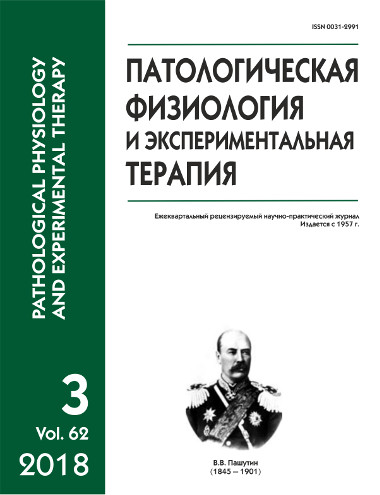Effect of neonatal administration of the opioid peptide dalargin on long-term cerebral consequences of antenatal hypoxia
Abstract
The aim of the study was to analyze the effect of δ/μ-agonist dalargin (Tyr-D-Ala-Gly-Phe-Leu-Arg) on brain morphology and function in mature albino rats exposed to antenatal hypoxia. Methods. Female rats were exposed to hypobaric hypoxia from gestation day 15 to day 19 day. The offspring was divided into 2 groups: 1) the first group, antenatal hypoxia (n = 12), where rats were injected with 0.1 ml of saline from 2 to 6 days of life, 2) the second group, antenatal hypoxia + dalargin (n = 17), where rats were injected with the peptide dalargin (100 mg/kg, i.p.) from 2 to 6 days of life. The control group (n = 25) included offspring of intact female rats. The size of neuronal nuclei and nucleoli in neocortical layers II and V and hippocampal area CA1 were measured on histological slides of the brain from 60-day old male rats. Intensity of free radical oxidation was determined by chemiluminescence in brain homogenates. Rat behavior was evaluated using the open field test and the elevated plus-maze test. Results. Antenatal hypoxia decreased body weight and weight of cerebral hemispheres in 60-day old male albino rats compared with the control. Antenatal hypoxia decreased the number of neuronal nucleoli in layer II of the neocortex and hippocampal area CA1, reduced neuronal nucleus size in layer V of the neocortex and the total area of neuronal nucleoli in all examined brain areas of 60-day-old male albino rats. Animals of this experimental group displayed increased motor activity. The chemiluminescence study of brain homogenates from 60-day-old animals showed increased free radical generation in brain tissues. Administration of dalargin reduced the morphofunctional cerebral consequences of antenatal hypoxia. Conclusion. Dalargin can be used for correcting long-term cerebral consequences of antenatal hypoxia.
Downloads
References
2. Belousova E.A., Bulgakov S.A. Drugs — ligands of opiate receptors and their use in gastroenterology. Farmateka. 2011; 2: 26-31. (in Russian)
3. Lihvanсev V.V., Grebenshсhikova O.A., Shaposhnikov A.A., Borisov K.V., Cherpakov R.A., Shul’gina N.M. Pharmacological preconditioning: role of opioid peptides. Obshchaya reanimatologiya. 2012; 3: 51-5. (in Russian)
4. Shmakov A.N., Danchenko S.V., Kasymov V.A. Dalargin in intensive care in criticall condition children. Detskaya meditsina Severo-Zapada. 2012; 1: 41-4. (in Russian)
5. Volkova O.V., Eleckij Ju.K. Fundamentals of histology and histological techniques. Moscow; Meditsina; 1982. (in Russian)
6. Korzhevskij D.Je. Method for detection of nucleoli in the nuclei of cells of different tissues. Arh. anat., gistol. i embr. 1990; 8(2): 58-60. (in Russian)
7. Mamaev N.N., Mamaeva C.E. Structure and function of argyrophilic nuclear organizer regions chromosomes: molecular, cytological, clinical aspects. Tsitologiya. 1992; 10: 3-12. (in Russian)
8. Lebed’ko O.A., Ryzhavskij B.Ja., Zadvornaja O.V. The free radical status of the neocortex of white rats and modification of derivatives of testosterone. Dal’nevostochnyy meditsinskiy zhurnal. 2011; 4: 95-9. (in Russian)
9. Vargas J.P., Rodriguez F., Lopez J.C., Arias J.L., Salas C. Spatial learning-induced increase in the argyrophilic nucleolar organizer region of dorsolateral telencephalic neurons in goldfish. Brain Res. 2000; 865(1): 77-84.
10. Garcia-Moreno L.M., Conejo N.M., Pardo H.G., Gomez M., Martin F.R., Alonso M.J. et al. Hippocampal AgNOR activity after chronic alcohol consumption and alcohol deprivation in rats. Physiol. Behav. 2001; 72(1-2): 115-21.
11. Parlato R., Kreiner G. Nucleolar activity in neurodegenerative diseases: a missing piece of the puzzle? J. Mol. Med. 2013; 91(5): 541-7.
12. Berciano M.T., Novell M., Villagra N.T., Casafont I., Bengoechea R., Val-Bernal J.F., Lafarga M. Cajal body number and nucleolar size correlate with the cell body mass in human sensory ganglia neurons. J. Struct. Biol. 2007; 158(3): 410-20.
13. Sazonova E.N., Simankova A.A., Lebed’ko O.A., Timoshin S.S. The effects of antenatal hypoxia on the behavioral responses of adult white rats. Dal’nevostochnyy meditsinskiy zhurnal. 2011; 4: 89-92. (in Russian)
14. Borlongan C.V., Wang Y., Su T.P. Delta opioid peptide (D-Ala 2, D-Leu 5) enkephalin: Linking hibernation and neuroprotection. Front. Biosci. 2004; 9: 3392-8.
15. Yang Y., Xia X., Zhang Y., Wang Q., Li L., Luo G. et al. delta-Opioid receptor activation attenuates oxidative injury in the ischemic rat brain. BMC Biol. 2009;7: 55.
16. D’Alecy L.G. Delta-1 opioid agonist acutely increases hypoxic tolerance. J. Pharmacol. Exp. Ther. 1994; 268(2): 683-8.
17. Bofetiado D.M., Mayfield K.P., D’Alecy L.G. Alkaloid d agonist BW 373U86 increases hypoxia tolerance. Anesth. Analg. 1996; 82(6): 1237-41.
18. Staples M., Acosta S., Tajiri N., Pabon M., Kaneko Y., Borlongan C.V. Delta opioid receptor and its peptide: a receptor-ligand neuroprotection. Int J Mol Sci. 2013; 23: 14(9): 17410-9.
19. Korobov N.V. Dalargin — an opioid-like peptide with peripheral action. Farmakologiya i toksikologiya. 1988; 51(4): 35-8. (in Russian)






